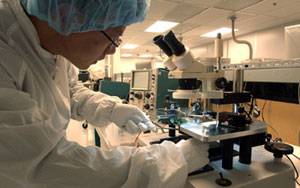New Clean Room opens doors for Texas State students
SAN MARCOS – The new clean room in the Mitte Complex at Texas State University-San Marcos hasn’t even been open a year, but already it’s making quite an impression.
 Shi Cheng Dong, a graduate student in Industrial Technology, tests the circuitry on a silicon wafer in the clean room at Texas State University. Photo by Don Anders | In just a short period of time, both bipolar and metal oxide silicon transistors--the first complex electronic devices ever created on the campus--have been produced, proving the lab’s capabilities. Transistors, the workhorse within a computer’s circuitry, are a mere half-micron across. To put that in perspective, the diameter of a human hair is 75 microns. All the more impressive once you realize the students working in the clean room are just as likely to be undergrads as they are graduate students. |
“ When we started the design of the clean room--which was before the Mitte Complex design was complete--we knew we wanted this to be an undergraduate-accessible clean room,” said Gene Stouder, holder of the endowed Mitte Chair for Microelectronics Manufacturing and Research. “That was a decision made by both the Technology Department and the Physics Department, because both departments are using it for undergraduate education.”
Equipped with two diffusion furnaces as well as a like number of wet and dry oxidation furnaces that can reach temperatures of 1,200 degrees centigrade, the lab allows students to introduce atoms into the four-inch silicon wafers used to build circuitry to create the semiconductor properties. The temperature in the room is carefully controlled and humidity is monitored. Every two minutes all the air in the room is completely changed and cleansed by 22 HEPA filters to remove microscopic dust and dirt particles that could contaminate the microscopic devices. The Texas State clean room is certified as Class 10,000, but has rarely exceeded a 1,000 particles per cubic foot count. For comparison, large commercial labs are certified as Class 100.
 Shi Cheng Dong prepares to examine microscopic transistors in the clean room at Texas State University. Photo by Don Anders | “Our undergraduates benefit by being exposed to the technology as well as the jargon. The undergraduates that have been in my classes have gone on to work in businesses around Austin that support the semiconductor industry or high-tech industry,” Stouder said. “Applied Materials, Tokyo Electron, AMD, Motorola--all are companies where our students have gone to work after completing this curriculum.” During the semester, up to 12 undergraduates may be working in the clean room in addition to graduate students involved in their own research projects. This summer, the clean room will also host a high school outreach program, bringing in science and math teachers for classes introducing them to the expanding world of technology. Texas State isn’t the only university in the state to boast a clean room--both the University of Texas at Austin and the University of Texas at Dallas have them--but it is primarily dedicated to teaching as opposed to being used exclusively for research. The total cost of the equipment used in the Texas State clean room is $219,000--some of which came from state funding and some which came as grants from the Society of Manufacturing Engineers. |
All the equipment is designed for teaching, explained Stouder, and some industry donation offers have been declined because their equipment is designed for larger silicon wafers and high volume. The cost of ownership of used, obsolete industrial equipment--including maintenance, installation and upkeep--is very high, so the university has to forego such donations, he said. However, the local semiconductor companies have been very generous with consumable supplies, clean room clothing and test equipment.
Specialized equipment is what enables commercial labs to produce high-grade, 22-layer silicon chips, whereas the lab at Texas State is limited to producing 5-8 layer chips. Even so, the Texas State clean room allows students to experience the procedures and processes very similar to those in the commercial sector.
“ I used to work in a clean room with Motorola, so I have some experience in the semiconductor industry,” said Shi Cheng Dong, a graduate student in Industrial Technology. “I think this is a pretty good lab. I can expand my experience and knowledge base here. It’s been valuable for me.”A
nd there’s more to come. Currently, the clean room boasts 2,000 square feet of lab space, but has the potential for modular expansion of more than 3,000 square feet. In addition, a vibration-free pad, isolated from the building itself, is already in place for use after future expansion.